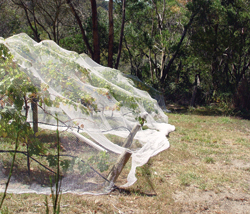
Features
Production
Research
Netting increases yield
But grape quality could be reduced, study finds
April 17, 2008 By Jim Meyers
Netting rows of grapes to keep out
ravenous birds may save the crop, but the increased yield could add to
the age-old discord between Ontario grape growers and wineries of
tonnage versus Brix (sugar level).
But grape quality could be reduced, study finds
 |
| An example of grape netting. Ontario research is using similar technology although darker netting is being used in vineyards. |
Netting rows of grapes to keep out ravenous birds may save the crop, but the increased yield could add to the age-old discord between Ontario grape growers and wineries of tonnage versus Brix (sugar level). And, like fishing, the trick is knowing when to drop the nets, a study last summer has found.
Dropped too soon and it’s felt they can impede photosynthesis and the potential Brix (sugar) level of the grape. And while netting increases tonnage because birds can’t get at the grapes, growers could in a bad year risk not meeting a minimum Brix level while in good years lose bonuses that are paid for grapes with higher sugar content.
Dropped too late and the nets are difficult if not impossible to position without potentially damaging the grape clusters while entangling the leaves and photosynthesis.
“Simply put, the Brix is lower with controls over no controls, but the yield is lower with no controls,” Helen Fisher said summing up the findings so far in the study at the Dollars For Nets Could Net You Dollars seminar at the Ontario Fruit and Vegetable Convention in February.
“We assumed nets would shade and decrease photosynthesis,” the viticulture research scientist at the University of Guelph’s department of plant agriculture at Vineland Station said. It’s believed the dark polyethylene nets cause 10 per cent shading of the plant.
What’s not known is just how much the nets reduce photosynthesis and the resulting sugar level, and how that factors in to the reduced Brix level from increased yield.
Prof. Fisher conducted the study on netting grapes last summer with Hugh Fraser who is with the Ontario Ministry of Agricultue and Food, also at Vineland Station. He’s an agricultural engineer and concluded that in his area of expertise, nets do work. Properly installed, they don’t interfere with spraying or with the mechanical harvesting. And netting means that grapes can be left longer without losing the crop to birds. In theory that should increase the Brix level. “And neighbors love nets because there’s no need for bird bangers,” he added.
Netting is being done in other grape growing areas of the world and in Niagara, temporary netting put up each year has been used to protect icewine grapes from birds. Commercially, Henry of Pelham winery in Niagara has used netting to protect some of its grape varieties.
The cost of netting is $2,500/acre including labour and the netting can last 10 years. Payback comes at less than eight per cent loss and, with netting, the crop was 50 per cent more than the uncontrolled (no netting) vines, he said about a study last summer on Cabernet Franc grapes.
“It can make the difference between a full crop versus no crop,” Hugh Fraser said about the appetite birds have for some grape varieties. “Birds sit on the wires (trellis) and feed off the grapes. A harvester couldn’t have cleaned the vines as well as the birds last year,” he said about a similar experiment netting Cabernet Sauvignon grapes.
The tests were conducted on the two varieties on the farm of Doug Whitty just west of St. Catharines. In the one study Cabernet Franc grapevines that were not netted yielded 1.5 kg/vine and a brix level of 21.4. That compares to a yield of 2.64 kg/vine and a brix level of 21 post bloom in late June; 2.88 kg/vine and a brix level of 20 when the nets were dropped in mid-season on August 4; and 2.88kg/vine and 19.7 brix when the nets were dropped just as the grapes were beginning to ripen two weeks later.
There was virtually no crop on the Cabernet Sauvignon that was not netted, and only a slight difference (2.39 kg/vine compared to 2.36 kg/vine) between grapes netted on July 5 and August 19.
“They have expensive tastes,” Doug Whitty said about the preference birds have for the higher value red grape varieties. “But that may be because they ripen later and are simply available.”
He said it’s discouraging seeing birds feasting on a crop you work all year to grow. “It’s nothing personal, but you feel it is,” he said about seeing a flock of birds pick one vine vineyard over another.
Such things as proximity to woodlots, ravines, water, hydro lines and bird flight paths add to the aggravation. “They’re site specific,” he said about why birds choose one vineyard over another.
Print this page